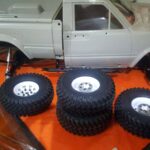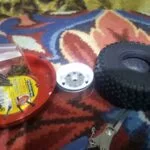6 Proven Ways To Identify Your RC Car (Solved)
Identifying an RC car is not an easy task. Since there are so many modifications and customizations that can be done to RC cars, you will encounter a wide variety of RC cars that are very hard to identify.
To identify an RC car we need to identify the different parts and components that it has – start by identifying the type of the RC car, than identify the motor, chassis, tyres and the serial number on each component
First We Need To Identify The Type Of The RC Car
Is it a buggy, a touring car, a monster truck, a crawler, or something completely different? Each type of RC car has it’s own characteristics:
- A buggy should have independent front suspension, a ground clearance of about 2 inches, a low center of gravity, a durable undercarriage, and in some instances all wheel drive.
- A touring car should have an enclosed body, very low ground clearance, slick tires, and small wheels.
- A monster truck should have a durable undercarriage, long suspension travel, lots of wheel travel, big tires (usually off-road type), and tend to appear “squared”.
- Crawlers are like monster trucks but appear to be flatter and they tend to use the same type of tread (or footprint) that would usually be found on a vehicle made for crawling over boulders.
If it is neither of these, then the car is probably something different and we should take a look at other possibilities.

The Next Step: Identify The Motor Or Engine
The motor or engine type is crucial when we try to identify an RC car. Not all cars use the same kind of motor.
We need to identify if it’s a motor (for electric RC) or an engine (for a nitro RC) and then identify the type of the motor\engine and find out if it has any serial no. on it.
Here are some examples:
Nitro engines: The most common and widely used engine for RC vehicles is a nitro engine. They look like a small jet engine and usually come with a muffler, a two-speed transmission, and a fuel tank.
Electric motor: Electric motors look like any other electric motor you might find elsewhere. They come in many different shapes and sizes but all of them are identified by the type of battery they need to operate (so knowing this information will make it much easier to identify an RC car).
Now let’s Identify The Chassis Or Frame
The chassis has different shapes and can be made out of different materials. The shape of the chassis can tell us a lot about the type of the RC car, and sometimes it can tell us who is the manufacturer.
The types of materials that can be found on an RC car frame\chassis are:
Plastic chassis: This type of frame is usually found on low-end RC cars. It needs to be handled with extreme care since it can break down pretty easily.
Aluminum chassis: This type of frame is usually found on higher end RC cars. It is much stronger than the cheap plastic chassis and it can take a lot more abuse.
Carbon fiber chassis: This type of frame is usually found on high-end RC cars. It’s incredibly strong and lightweight, but not often seen because of its high price tag.
Chassis shape:
- A rock crawler or a monster truck will often have a square chassis. that sits above the center of the wheels, for high ground clearance.
- A buggy will have a kind of a triangled shaped chassis (wide at the back and narrow at the front) that sits on top of the center of the wheels for improved grip and control.
- A touring RC car will have a low chassis that sits below the center of the wheels for a lower center of gravity and better road grip. The shape of the chassis is usually rectangular.
- If it happens to be a drag racer then the chassis is usually long and slim.
What Tyres And Suspension Your RC Car Has?
Just as at a conventional car, the type of tyres and suspension can help us identify the type of an RC car, and then the brand or even the model. Off-road tyres, for example, will be a lot different than touring car tyres or buggy tyres.
Tyres:
We can break this into 3 segments:
Low grip tyres: These types of tires have a soft rubber compound and provide low levels of traction. It will be slick, the center of the tire will have a shallow tread, and there will not be lots of sidewall on the tires.
Medium grip tyres: These types of tires have a medium soft rubber compound and provide good levels of traction. It will have a medium tread, sometimes with spikes on the tread. There will be lots of sidewall on the tires.
High-grip tyres: These types of tires have a soft rubber compound and provide excellent levels of traction. The size of the tire’s footprint is usually large with deep tread on either side, like a conventional SUV tire.
Suspension:
The most common type of suspension on an RC car is known as “4-wheel independent” (or 4-wheel suspension system). This suspension type employs one shock absorber per wheel.
Double wishbone: A double wishbone suspension usually uses a long upper control arm and a short lower control arm with a ball joint at each end. It allows the chassis to roll more easily through corners.
Another type of suspension that is sometimes found on an RC car is a live axle. This suspension type uses a solid piece of metal instead of shock absorbers to help the wheels move up and down independently from each other.
What Do The Numbers On RC Cars Mean?
Most of the numbers you see on an RC car are serial numbers. There are serial numbers on some parts of the RC car which you should check. The numbers will be a combination of 3 to 6 digits, sometimes underlined while other times not.
This number tells you the product number of the car or at least which version it is. You can use this number when looking for manuals, spare parts, etc.
It can be a good idea to search those numbers in google with the brand of the car (if you know it) and with the words “serial no.”
numbers that aren’t serial numbers can also be found on the RC car body or chassis that will be either molded into it or printed on. It’s with checking those numbers on google as well.
How do you tell what scale RC car I have?
This is a question that many RC car owners have. As you probably already know, the scale of an RC car refers to its size compared to a real vehicle. There are three common scales:
1/10th Scale
This is the most popular scale because it’s large enough to carry standard hobby-class electronics and motors, but not too large to be expensive.
1/12th Scale
This smaller scale is popular among drivers who want the stability of 1/10th vehicles but don’t want to carry around a larger, heavier car.
1/16th Scale
This scale is smaller and it provides drivers with a great sense of speed. It’s also very popular among young racers who want to race against other kids the same age.
It’s actually pretty hard to know what scale your RC car is without identifying the brand and looking it up. Because the scale is relative to the real car it’s based on, then the size of the RC will tell you nothing without knowing what car you have.
In other words, if you want to know the scale of your RC car, it’s best to know the model and manufacturer of the car.
Conclusion
If you just got an RC car and you are trying to identify it, know that it’s a task that will require quite a bit of a research. If you will follow our guide here, however, you most likely will be able to identify your RC car.
if all of that didn’t help, it’s always a good idea to go to your local hobby store and see if they can identify your RC car for you.





